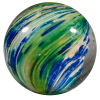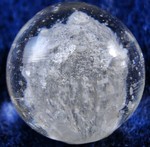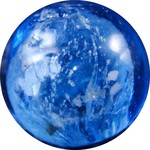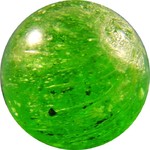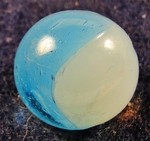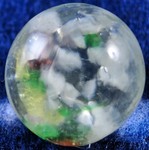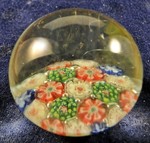OTHER HANDMADE GLASS MARBLES
A Mica marble is a transparent base glass with mica flakes in it.
The most common colors are clear, blue, aqua, brown, and green. Olive green and smoky gray are less common. Amethyst is rare. Yellow is rarer. Red
micas are not quite as rare as true yellow, but are valued higher, probably because they are prettier.
Some Micas have ghost cores (cores of tiny air bubbles) or thin dark filaments. These are odd, but do not seem to add greatly to the value of the marble.
Single-pontil, multi-layer, cased, single-gather or end-of-cane marbles are very rare.
Click any marble below for a full-screen image.
A Slag is a marble that is made from a cane that is a mixture of black and white glass. Rather than being a layered cane, like a Swirl or End of Day, Slags are drawn off of a cane that is a mixture of two colors. Single pontil examples are discussed in the transitional section.
An Opaque is made from a rod of a single opaque color.
White and black are the most common. White or black opaques under 5/8” are usually Ballot Box marbles. Blue, pink, and green are rarer. Some are referred to as Melon Balls. Other opaque, pastel or translucent colors are even rarer. Single pontil marbles, either single-gather or end- of-cane are very rare.
There is also a type of Opaque made from a rod of two opaque or translucent colors. The rod had one color (usually
semi-opaque white) on one side and another color (usually semi-opaque green or blue) on the other. When the marble was twisted off the end, one side of
the marble is one color and the other side is the other color. Because of the twisting motion, the marble looks like a machine-made
corkscrew, but has two pontils, hence the name “handmade corkscrew”. These are very rare.
A Clearie marble is made from a rod of a single transparent color. Clear is the most common, although light blue, light green, and light amber examples are known. Single pontil examples, either single-gather or end-of-cane, are rarer.
Most varieties of cane-cut handmade marbles can also be found as single-pontil marbles. However, almost all of these are end-of-cane marbles, not single-gather marbles. A single-gather marble is a marble that was produced one at a time by adding successive layers of glass onto the end of a punty.
Several types of cane-cut marbles were also produced as single-gather marbles. These are End of Day Clouds, Micas, and Opaques. However, the single-gather versions are
much rarer than the cane-cut versions.
Aside from Sulphides, there are two types of marble that were produced solely as a single-gather marble. The first is the Confetti marble. A
Confetti marble is a transparent glass base with small flecks or chips of colored glass forming a layer near the pontil of the marble. The marbles are rare. Almost all
have a transparent clear base. I have only seen one with a transparent colored base, and that one was blue. The colored flecks are usually white,
pink, yellow or green. I have only seen them in 9/16” to 3/4” size. Larger sizes are very rare, if they exist at all.
A rarer type of single-gather marble is the Paperweight marble. This has a layer of millefiori canes at the base.


